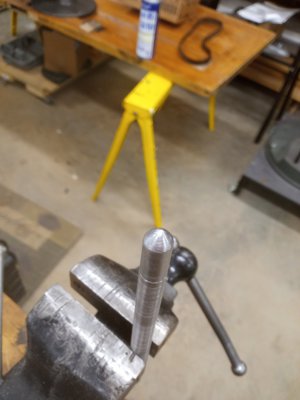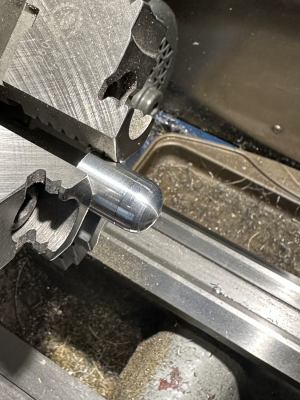Based on your description I am really questioning whether my Clausing lathe has the capability of doing this - specifically the ability to get the tool behind the pivot point.
This is why I threw in there to mock it up instead of calculating this in your head from scratch. You may very well not be able to, but if you are creative, maybe. Or maybe not..... Also, I never gave it a thought, but it was mentioned... Because my lathe is not appropriate (threaded chuck), so turning backwards is a poor choice. And my cross slide and compound are not heavy enough to consider cutting forward on the back side with the tool upside down, That's just out of the question for me. But other lathes are quite capable of either or both. Maybe yours is capable? That lets you be on the opposite side of the pivot center. It's not much, but that buys you another half an inch in tool position. Maybe that's enough? Like I said, I suspect that not all lathes are capable of this, but fitting it up and playing with it is pretty much free, and maybe when you get part way there, it's easier to see what's got to change or be different, and a whole new and different tool mounting (or anything else) comes to you in the process. Or maybe not.
I may be better off with either one of the ball turners Amazon offers or a form tool. It seems the ball turner offers some benefit in that it can be used across multiple sizes where as a form tool is specific to one feature. Any thoughts on that?
Rick
That should get it done, and probably quite quickly. If that's going to be a regular ongoing thing, I honestly might try both. If your lathe, and your material can lets you drive a form tool straight in there with zero complaints, then that's the way to to do it, all day long. If that's fussy or fiddly, chatters too much, or otherwise just isn't working out, then a proper ball turner, after it's all set up and dialed in, would knock those out quite readily. If this is a one off job, at a half an inch... You "could" make a cardboard cutout and work your way in with an appropriate file. That'd probably go really fast if you put a heavy 45 degree chamfer on the end of the part first. But while doable, if I was doing a dozen... Maybe not so much so. There's a lot of ways here. Me, personally, I like the challenge of making something with nothing, and I'll spend some time at figuring out how to do it. Sometimes I spend a lot of time. Not everybody has that same mindset about such things, and nobody's "wrong" in what gives them enjoyment or when that adventure turns to frustration. And in my case because my lathe makes this job easy, I have had zero problems setting this up two times in my life. Three if you count a proof of concept run. But if I come to a dead end and I want it done "now", or if my workaroundd gets too fiddly, or if I have a deadline (rare in my world), I don't have any regrets in finding a pre-made solution that's quick and efficient either. Within reason, and within what finances I'm willing to devote to a hobby or to a specific project.... There is a reason that form tools and ball cutters are so readily available. I might have a ball cutter one day even though I can get by without.



